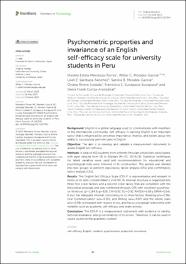| dc.contributor.author | Mendoza-Torres, Mariela Estela | |
| dc.contributor.author | Morales-García, Wilter C. | |
| dc.contributor.author | Sairitupa-Sanchez, Liset Z. | |
| dc.contributor.author | Morales-García, Sandra B. | |
| dc.contributor.author | Rivera-Lozada, Oriana | |
| dc.contributor.author | Sucapuca-Sucapuca, Francisco E. | |
| dc.contributor.author | Cunza-Aranzábal, Denis Frank | |
| dc.date.accessioned | 2023-10-10T15:11:33Z | |
| dc.date.available | 2023-10-10T15:11:33Z | |
| dc.date.issued | 2023-06-15 | |
| dc.identifier.uri | https://hdl.handle.net/20.500.13053/9512 | |
| dc.description.abstract | “Background: English is a global language used to communicate with members
of the international community. Self-efficacy in learning English is an important
factor that is influenced by perceived importance, interest, and beliefs about the
ability to successfully perform tasks in English.
Objective: The aim is to develop and validate a measurement instrument to
assess English self-efficacy.
Methods: A total of 453 students from different Peruvian universities participated,
with ages ranging from 18 to 60 years (M = 23; SD = 6.18). Statistical techniques
for latent variables were used and recommendations for educational and
psychological tests were followed in its construction. The sample was divided
into two groups to perform exploratory factor analysis (EFA) and confirmatory
factor analysis (CFA).
Results: The English Self-Efficacy Scale (ESS-P) is representative and relevant in
terms of its item content (Aiken’s V > 0.70). Its internal structure is organized into
three first order factors and a second order factor that are consistent with the
theoretical proposal and was confirmed through CFA with excellent goodnessof-fit indices (χ2
= 1184.9, gl = 626, CFI = 0.92, TLI = 0.92, RMSEA = 0.06 y SRMR = 0.04).
It also has adequate internal consistency in its three factors (Reading α/ω = 0.96),
Oral Communication (α/ω = 0.95), and Writing (α/ω = 0.97) and the whole scale
(α/ω = 0.98), is invariant with respect to sex, and has a conceptual relationship with
variables such as academic self-efficacy and exam anxiety.
Conclusion: The ESS-P is a measurement instrument with evidence of validity,
factorial invariance, and good reliability of its scores. Therefore, it can be used in
future studies in the academic contex“ | es_PE |
| dc.format | application/pdf | es_PE |
| dc.language.iso | eng | es_PE |
| dc.publisher | FRONTIERS MEDIA SA | es_PE |
| dc.rights | info:eu-repo/semantics/openAccess | es_PE |
| dc.rights.uri | https://creativecommons.org/licenses/by/4.0/ | es_PE |
| dc.subject | self-efficacy, English, students, psychometric properties, invariance | es_PE |
| dc.title | Psychometric properties and invariance of an English self-efficacy scale for university students in Peru | es_PE |
| dc.type | info:eu-repo/semantics/article | es_PE |
| dc.identifier.doi | 10.3389/fpsyg.2023.1187342 | |
| dc.type.version | info:eu-repo/semantics/publishedVersion | es_PE |
| dc.publisher.country | CHE | es_PE |
| dc.subject.ocde | 3.03.00 -- Ciencias de la salud | es_PE |


